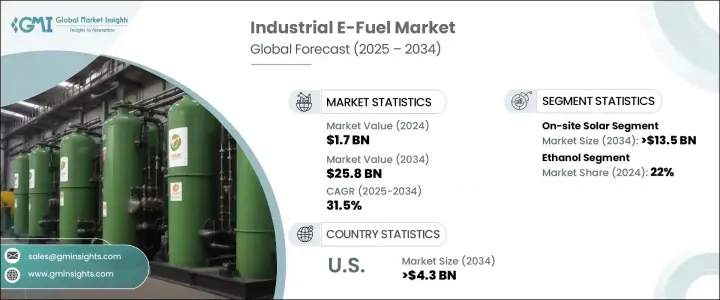
|
시장보고서
상품코드
1750594
산업용 합성연료(E-fuel) 시장 기회, 성장 촉진요인, 산업 동향 분석 및 예측(2025-2034년)Industrial E-Fuel Market Opportunity, Growth Drivers, Industry Trend Analysis, and Forecast 2025 - 2034 |
||||||
세계의 산업용 합성연료(E-fuel) 시장은 2024년에는 17억 달러로 평가되었으며, 세계 탈탄소화 추진과 산업용도에서 지속 가능한 대체 에너지에 대한 요구 증가에 따라 CAGR 31.5%를 나타내 2034년에는 258억 달러에 이를 것으로 추정되고 있습니다.
산업계가 기존의 화석연료를 대체할 수 있는 대체연료를 모색하는 가운데 e-fuel은 제조, 대형 운송, 항공 등의 분야에서 설득력 있는 솔루션으로 부상하고 있습니다.

게다가 자연 에너지와 산업 사업의 통합이 중시됨에 따라 기업은 장기적인 탄소 중립 에너지 틀을 채택하게 되었습니다. 적극적이고 강인한 에너지 공급망으로의 움직임은 환경 규제뿐만 아니라 지역 밀착형 청정 에너지 생산이 초래하는 경제적 이점에도 뒷받침되고 있습니다.
| 시장 범위 | |
|---|---|
| 시작 연도 | 2024년 |
| 예측 연도 | 2025-2034년 |
| 시작 금액 | 17억 달러 |
| 예측 금액 | 258억 달러 |
| CAGR | 31.5% |
현장 태양광 발전 분야는 Power-to-X 프로세스에 필요한 재생 가능 전력을 공급하는 중요한 공헌을 반영하여 2034년까지 135억 달러를 창출할 것으로 예측되고 있습니다. 트럴 연료 생산을 지원하고 산업계가 지속가능성 목표를 달성하는 데 도움이 됩니다. 고급 제어 시스템과 지원 정책 프레임 워크는 비 전기 재생에너지 발전으로의 전환을 촉진하고 분산 합성연료 사업과 원활하게 일치합니다.
에탄올 분야는 2024년에 22%의 점유율을 차지했으며, 2034년까지의 CAGR은 32%를 나타낼 것으로 예측됩니다. 이에 따라 바이오의 에탄올은 산업계가 탈탄소화의 의무에 대응하기 위한 유연한 솔루션을 요구하는 가운데, 기세를 늘리고 있습니다.
2024년 미국의 산업용 합성연료(E-fuel) 시장 규모는 2억 3,540만 달러로 평가되었고, 2034년에는 43억 달러에 이를 것으로 추정됩니다. 이를 위해 다양한 태양광·풍력자원을 활용해 나가고 있습니다.
eFuel Pacific, Climeworks, Electrochaea, Archer Daniels Midland, Ballard Power Systems, MAN Energy Solutions, INFRA Synthetic Fuels, Porsche, HIF Global, Clean Fuels Alliance America, Sunfire, Arcadia eFuels, Liquid Wind, LanzaJet, e-Fuel, ExxonMobil, Ceres Power 등의 주요 기업은 기술 혁신, 합작사업, 지속가능한 기술 개발을 통해 그 지위를 강화하고 있습니다.
목차
제1장 조사 방법과 범위
제2장 주요 요약
제3장 업계 인사이트
- 생태계 분석
- 트럼프 정권의 관세 분석
- 무역에 미치는 영향
- 무역량의 혼란
- 보복 조치
- 업계에 미치는 영향
- 공급측의 영향(원재료)
- 주요 원재료의 가격 변동
- 공급망 재구성
- 생산 비용에 미치는 영향
- 수요측의 영향(판매가격)
- 최종 시장에의 가격 전달
- 시장 점유율 동향
- 소비자의 반응 패턴
- 공급측의 영향(원재료)
- 영향을 받는 주요 기업
- 전략적인 업계 대응
- 공급망 재구성
- 가격 설정 및 제품 전략
- 정책관여
- 전망과 향후 검토 사항
- 무역에 미치는 영향
- 규제 상황
- 업계에 미치는 영향요인
- 성장 촉진요인
- 업계의 잠재적 리스크 및 과제
- 성장 가능성 분석
- Porter's Five Forces 분석
- PESTEL 분석
제4장 경쟁 구도
- 서론
- 전략적 대시보드
- 전략적 노력
- 기업의 시장 점유율 분석
- 경쟁 벤치마킹
- 혁신과 기술 상황
제5장 시장 규모와 예측 : 재생에너지원별(2021-2034년)
- 주요 동향
- 현장 태양광
- 풍력
제6장 시장 규모와 예측 : 기술별(2021-2034년)
- 주요 동향
- 피셔-트롭쉬
- eRWGS
- 기타
제7장 시장 규모와 예측 : 제품별(2021-2034년)
- 주요 동향
- e-가솔린
- e-디젤
- e-등유
- 에탄올
- e-메탄올
- 기타
제8장 시장 규모와 예측 : 지역별(2021-2034년)
- 주요 동향
- 북미
- 미국
- 캐나다
- 유럽
- 영국
- 독일
- 프랑스
- 네덜란드
- 스페인
- 아시아태평양
- 중국
- 인도
- 일본
- 한국
- 호주
- 중동 및 아프리카
- 사우디아라비아
- 아랍에미리트(UAE)
- 남아프리카
- 라틴아메리카
- 브라질
- 아르헨티나
제9장 기업 프로파일
- Archer Daniels Midland
- Arcadia eFuels
- Ballard Power Systems
- Ceres Power
- Clean Fuels Alliance America
- Climeworks
- Electrochaea
- eFuel Pacific
- ExxonMobil
- FuelCell Energy
- HIF Global
- INFRA Synthetic Fuels
- LanzaJet
- Liquid Wind
- MAN Energy Solutions
- Norsk e-Fuel
- Porsche
- Sunfire
The Global Industrial E-Fuel Market was valued at USD 1.7 billion in 2024 and is estimated to grow at a CAGR of 31.5% to reach USD 25.8 billion by 2034, driven by the global push toward decarbonization and the rising need for sustainable energy alternatives across industrial applications. As industries search for viable replacements for conventional fossil fuels, e-fuels have emerged as a compelling solution for sectors such as manufacturing, heavy transport, and aviation. The integration of advanced production technologies, coupled with improvements in efficiency and cost control, continues to enhance the viability of these synthetic fuels. Supportive government initiatives, clean energy incentives, and global emission reduction targets accelerate adoption.

Moreover, the heightened emphasis on integrating renewables with industrial operations encourages businesses to adopt long-term, carbon-neutral energy frameworks. Companies align their strategies with global sustainability targets, prioritizing low-emission fuels that reduce dependence on traditional fossil energy sources. The move toward stable and resilient energy supply chains is not only driven by environmental regulations but also by the economic advantages of localized, clean energy production. This trend unlocks new potential for e-fuels, especially in hard-to-decarbonize sectors where renewable electricity alone may not suffice.
| Market Scope | |
|---|---|
| Start Year | 2024 |
| Forecast Year | 2025-2034 |
| Start Value | $1.7 billion |
| Forecast Value | $25.8 billion |
| CAGR | 31.5% |
The on-site solar segment is projected to generate USD 13.5 billion by 2034, reflecting its critical contribution in providing the renewable electricity required for Power-to-X processes. These renewable energy sources support carbon-neutral fuel production and help industries meet sustainability goals. Advanced control systems and supportive policy frameworks fuel the shift toward off-grid renewable generation, which aligns seamlessly with decentralized e-fuel operations.
The ethanol segment held a 22% share in 2024 and is projected to grow at a CAGR of 32% through 2034. Its compatibility with current fuel infrastructure and ease of integration into various industrial processes have made ethanol a reliable and scalable alternative. With ongoing advances in production technologies, bio-based ethanol is gaining momentum as industries seek flexible solutions to meet decarbonization mandates. Its ability to blend seamlessly with other synthetic fuels enhances its appeal in industrial settings, transitioning toward sustainable energy.
United States Industrial E-Fuel Market generated USD 235.4 million in 2024 and is estimated to reach USD 4.3 billion by 2034, underpinned by supportive federal policies, clean energy funding programs, and increasing deployment of renewable technologies. The U.S. continues to leverage a diverse mix of solar and wind resources to support e-fuel production through Power-to-X and other emerging pathways. Coupled with advancements in fuel synthesis and carbon capture technologies, these efforts are helping to cement the U.S. as a global frontrunner in the industrial e-fuel transition.
Key players such as eFuel Pacific, Climeworks, Electrochaea, Archer Daniels Midland, Ballard Power Systems, MAN Energy Solutions, INFRA Synthetic Fuels, Porsche, HIF Global, Clean Fuels Alliance America, Sunfire, Arcadia eFuels, Liquid Wind, LanzaJet, FuelCell Energy, Norsk e-Fuel, ExxonMobil, and Ceres Power are strengthening their position through innovation, joint ventures, and sustainable technology development. These companies are focused on expanding production capacity, investing in renewable-powered facilities, and forming strategic alliances to accelerate commercialization. Many are also leveraging carbon capture technologies and creating integrated supply chains to support scalable, clean fuel distribution.
Table of Contents
Chapter 1 Methodology & Scope
- 1.1 Market definitions
- 1.2 Base estimates & calculations
- 1.3 Forecast calculation
- 1.4 Data sources
- 1.4.1 Primary
- 1.4.2 Secondary
- 1.4.2.1 Paid
- 1.4.2.2 Public
Chapter 2 Executive Summary
- 2.1 Industry synopsis, 2021 - 2034
Chapter 3 Industry Insights
- 3.1 Industry ecosystem analysis
- 3.2 Trump administration tariff analysis
- 3.2.1 Impact on trade
- 3.2.1.1 Trade volume disruptions
- 3.2.1.2 Retaliatory measures
- 3.2.2 Impact on the industry
- 3.2.2.1 Supply-side impact (raw materials)
- 3.2.2.1.1 Price volatility in key materials
- 3.2.2.1.2 Supply chain restructuring
- 3.2.2.1.3 Production cost implications
- 3.2.2.2 Demand-side impact (selling price)
- 3.2.2.2.1 Price transmission to end markets
- 3.2.2.2.2 Market share dynamics
- 3.2.2.2.3 Consumer response patterns
- 3.2.2.1 Supply-side impact (raw materials)
- 3.2.3 Key companies impacted
- 3.2.4 Strategic industry responses
- 3.2.4.1 Supply chain reconfiguration
- 3.2.4.2 Pricing and product strategies
- 3.2.4.3 Policy engagement
- 3.2.5 Outlook and future considerations
- 3.2.1 Impact on trade
- 3.3 Regulatory landscape
- 3.4 Industry impact forces
- 3.4.1 Growth drivers
- 3.4.2 Industry pitfalls & challenges
- 3.5 Growth potential analysis
- 3.6 Porter's Analysis
- 3.6.1 Bargaining power of suppliers
- 3.6.2 Bargaining power of buyers
- 3.6.3 Threat of new entrants
- 3.6.4 Threat of substitutes
- 3.7 PESTEL Analysis
Chapter 4 Competitive landscape, 2025
- 4.1 Introduction
- 4.2 Strategic dashboard
- 4.3 Strategic initiatives
- 4.4 Company market share analysis
- 4.5 Competitive benchmarking
- 4.6 Innovation & technology landscape
Chapter 5 Market Size and Forecast, By Renewable Source, 2021 - 2034 (USD Million)
- 5.1 Key trends
- 5.2 On-site solar
- 5.3 Wind
Chapter 6 Market Size and Forecast, By Technology, 2021 - 2034 (USD Million)
- 6.1 Key trends
- 6.2 Fischer-tropsch
- 6.3 eRWGS
- 6.4 Others
Chapter 7 Market Size and Forecast, By Product, 2021 - 2034 (USD Million)
- 7.1 Key trends
- 7.2 E-gasoline
- 7.3 E-diesel
- 7.4 E-kerosene
- 7.5 Ethanol
- 7.6 E-methanol
- 7.7 Others
Chapter 8 Market Size and Forecast, By Region, 2021 - 2034 (USD Million)
- 8.1 Key trends
- 8.2 North America
- 8.2.1 U.S.
- 8.2.2 Canada
- 8.3 Europe
- 8.3.1 UK
- 8.3.2 Germany
- 8.3.3 France
- 8.3.4 Netherlands
- 8.3.5 Spain
- 8.4 Asia Pacific
- 8.4.1 China
- 8.4.2 India
- 8.4.3 Japan
- 8.4.4 South Korea
- 8.4.5 Australia
- 8.5 Middle East & Africa
- 8.5.1 Saudi Arabia
- 8.5.2 UAE
- 8.5.3 South Africa
- 8.6 Latin America
- 8.6.1 Brazil
- 8.6.2 Argentina
Chapter 9 Company Profiles
- 9.1 Archer Daniels Midland
- 9.2 Arcadia eFuels
- 9.3 Ballard Power Systems
- 9.4 Ceres Power
- 9.5 Clean Fuels Alliance America
- 9.6 Climeworks
- 9.7 Electrochaea
- 9.8 eFuel Pacific
- 9.9 ExxonMobil
- 9.10 FuelCell Energy
- 9.11 HIF Global
- 9.12 INFRA Synthetic Fuels
- 9.13 LanzaJet
- 9.14 Liquid Wind
- 9.15 MAN Energy Solutions
- 9.16 Norsk e-Fuel
- 9.17 Porsche
- 9.18 Sunfire













